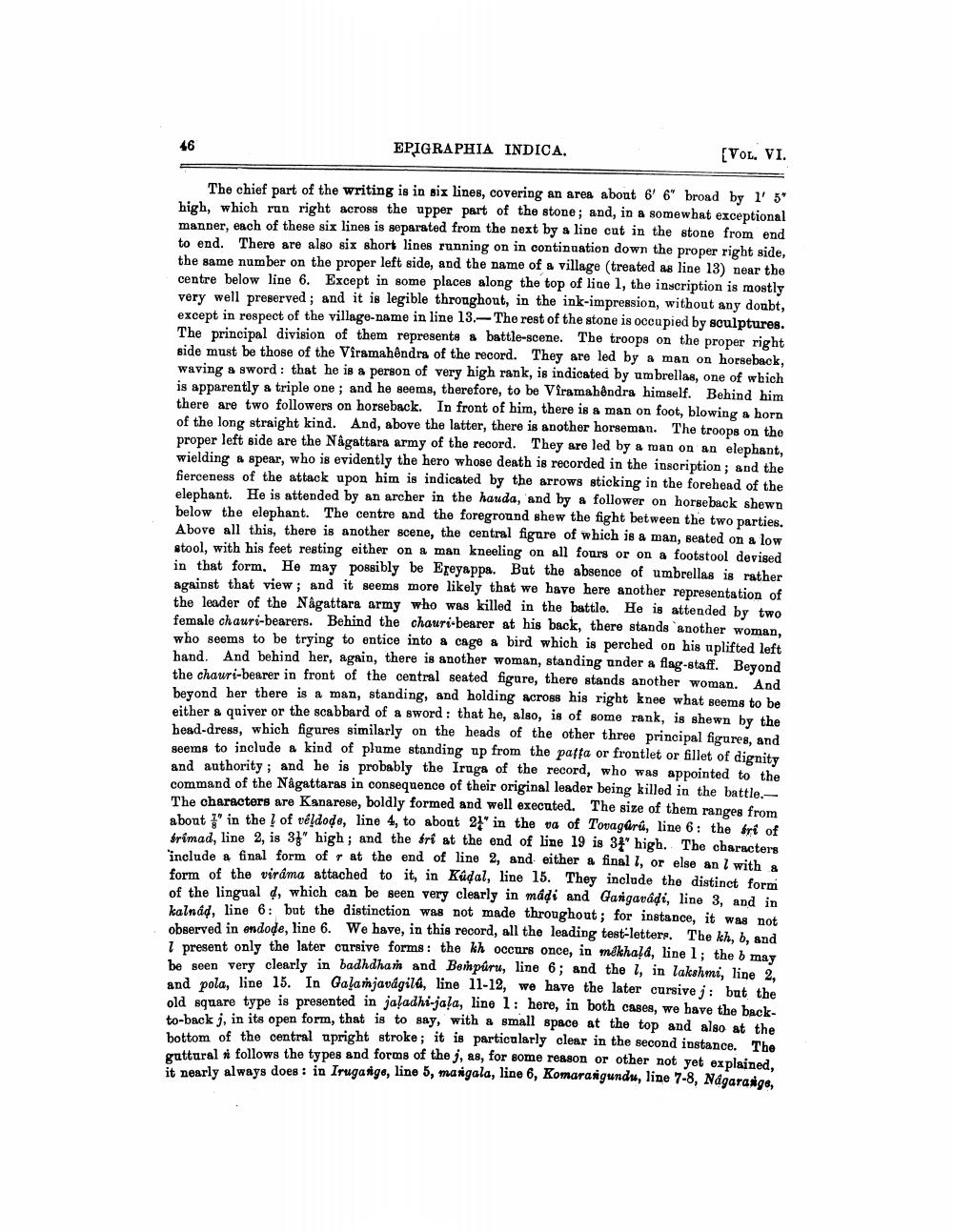________________
EPIGRAPHIA INDICA,
[Vol. VI.
The chief part of the writing is in six lines, covering an area about 6' 6" broad by 1' 5" high, which run right across the upper part of the stone; and, in a somewhat exceptional manner, each of these six lines is separated from the next by a line cut in the stone from end to end. There are also six short lines running on in continuation down the proper right side, the same number on the proper left side, and the name of a village (treated as line 13) near the centre below line 6. Except in some places along the top of line 1, the inscription is mostly very well preserved ; and it is legible throughout, in the ink-impression, without any doubt, except in respect of the village-name in line 13.- The rest of the stone is occupied by sculptures. The principal division of them represents a battle-scene. The troops on the proper right side must be those of the Viramahồndra of the record. They are led by a man on horseback, waving a sword : that he is a person of very high rank, is indicated by umbrellas, one of which is apparently a triple one ; and he seems, therefore, to be Viramahêndra himself. Behind him there are two followers on horseback. In front of him, there is a man on foot, blowing a horn of the long straight kind. And, above the latter, there is another horseman. The troops on the proper left side are the Nâgattara army of the record. They are led by a man on an elephant, wielding & spear, who is evidently the hero whose death is recorded in the inscription; and the fierceness of the attack upon him is indicated by the arrows sticking in the forehead of the elephant. He is attended by an archer in the hauda, and by a follower on horseback shewn below the elephant. The centre and the foreground shew the fight between the two parties. Above all this, there is another scene, the central figure of which is a man, seated on a low stool, with his feet resting either on a man kneeling on all fours or on a footstool devised in that form. He may possibly be Ereyappa. But the absence of umbrellas is rather against that view; and it seems more likely that we have here another representation of the leader of the Nagattara army who was killed in the battle. He is attended by two female chauri-bearers. Behind the chauri-bearer at his back, there stands another woman, who seems to be trying to entice into a cage a bird which is perched on his uplifted left hand. And behind her, again, there is another woman, standing under a flag-staff. Beyond the chauri-bearer in front of the central seated figure, there stands another woman. And beyond her there is a man, standing, and holding across his right knee what seems to be either & quiver or the scabbard of a sword : that he, also, is of some rank, is shewn by the head-dress, which figures similarly on the heads of the other three principal figures, and seems to include a kind of plume standing up from the paffa or frontlet or fillet of dignity and authority; and he is probably the Iraga of the record, who was appointed to the command of the Nâgattaras in consequence of their original leader being killed in the battle. The characters are Kanarese, boldly formed and well executed. The size of them ranges from about " in the l of véļdode, line 4, to about 21" in the va of Tovagarů, line 6: the fri of Srimad, line 2, is 31" high; and the fri at the end of line 19 is 34' high. The characters include a final form of at the end of line 2, and either a final l, or else an l with a form of the viráma attached to it, in Kúdal, line 15. They include the distinct form of the lingual d, which can be seen very clearly in madi and Garigavadi, line 3, and in kalnad, line 6: but the distinction was not made throughout; for instance, it was not observed in ondode, line 6. We have, in this record, all the leading test-letters. The kh, b, and 1 present only the later cursive forms: the kh occurs once, in mekhaļa, line 1; the b may be geen very clearly in badhdhar and Bempúru, line 6; and the l, in lakshmi, line 2. and pola, line 15. In Galanjavägila, line 11-12, we have the later cursive j: but the old square type is presented in jaladhi-jala, line 1: here, in both cases, we have the backto-back j, in its open form, that is to say, with a small space at the top and also at the hottom of the central upright stroke; it is particularly clear in the second instance. The guttural follows the types and forms of the j, as, for some reason or other not yet explained. it nearly always does : in Irugange, line 5, mangala, line 6, Komarangundu, line 7-8, Nagarange,




